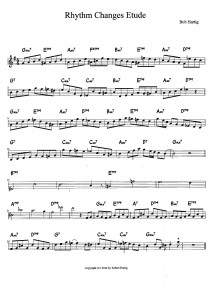 Here’s a little bop-style etude I created to help build your chops for rhythm changes. No surprises here; I wasn’t striving for cutting-edge ideas but for simple building blocks of jazz vocabulary. Me being an alto sax guy, I’ve written the material in the key of G, which is the alto transposition for the standard “Rhythm” key of Bb. Tenor players, flute players, and so on–sorry for the inconvenience, but you know how to transpose, right? Or just play it as written and hone your facility with the key of G. Click on the image to enlarge it and then have at it. And have fun!
Here’s a little bop-style etude I created to help build your chops for rhythm changes. No surprises here; I wasn’t striving for cutting-edge ideas but for simple building blocks of jazz vocabulary. Me being an alto sax guy, I’ve written the material in the key of G, which is the alto transposition for the standard “Rhythm” key of Bb. Tenor players, flute players, and so on–sorry for the inconvenience, but you know how to transpose, right? Or just play it as written and hone your facility with the key of G. Click on the image to enlarge it and then have at it. And have fun!
I’ve written in the past about my predilection for rhythm changes as a means of developing a fundamental jazz vocabulary. In their essence, the changes can be construed as simply a succession of turnarounds with a bridge based on the cycle of dominants. You can get as fancy with that as you want to, but the basics are just as simple as the word basic implies.
For more on rhythm changes, click here. I also encourage you to read the point-counterpoint between Kurt Ellenberger and me which evolved out of that post. Whether you love rhythm changes or, like Kurt, hate them, you’ll find food for thought.
If you enjoyed this post, click here for plenty more articles, exercises, and solo transcriptions. Also, a quick plug for my book The Giant Steps Scratch Pad. If you’d like a practical, hands-on practice companion to help you master “Giant Steps,” well…that’s why I wrote it.

